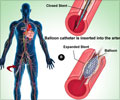Heart muscle can continue to die even after restoring blood following a heart attack. Scientists found a new way for the muscle to live after the attack.

‘MiR322 can reduce heart damage by increasing the levels of endogenous heart cell protector Notch 1. It could be used in the immediate aftermath of a heart attack to reduce permanent heart damage soon.’
Read More..




Tang and his team were looking for better ways to protect the heart from additional damage, doing high throughput analysis of microRNAs, which help regulate gene function, and miR322 was the first standout as the most dramatically reduced after blood flow to the heart was restored. Read More..
So Tang’s team began looking for the source of miR322 in adult hearts -- which turned out to be the endothelial cells that line the blood vessels -- and in the process they also found miR322’s target.
For these studies, they caused an occlusion in the left coronary artery of mice for about 45 minutes, then enabled reperfusion to reflect what happens when a human has a heart attack, then gets treatment. During the period of ischemia --when the heart attack happens -- they saw seriously reduced miR322 levels, which recovered after blood and oxygen were restored but dropped dramatically again one day later, the lowest point was seven days later.
When they increased miR322 by giving what scientists call its mimic, they saw levels of the endogenous heart cell protector Notch 1 significantly increase while levels of cell suicide promoter FBXW7 significantly decreased, and heart damage reduced.
When they gave both miR322 mimic and FBXW7 plasmid -- a plasmid is small DNA molecule, which can be used to increase expression of a gene -- Notch 1 levels instead decreased and the heart benefit was lost, implicating FBXW7 as a direct target of miR322.
Advertisement
While the half-life of miR322 is just a few seconds and it’s very expensive, it likely could one day be used in the immediate aftermath of a heart attack to reduce permanent heart damage, Tang says. A great therapeutic advantage is that it’s so small it’s easily taken up by heart cells, he adds. Still a better option might be finding a way to instead bolster the body’s natural method for increasing miR322, which the team is now looking to find.
Advertisement
However solutions, including cardiac bypass surgery and angioplasty to reopen blocked coronary arteries, can result in a second period of adjustment and injury that can be responsible for as much as half of the size of the damage done to the heart muscle, called the infarct size.
If it seems odd that reestablishing blood rich in oxygen and nutrients back to heart cells that are screaming for both and dying without them, would also cause injury, Tang explains that it’s a fragile transition period. When oxygen levels drop, heart cells’ metabolic rate drops as well to reduce their needs, much like cooling the body during cardiac surgery.
"Heart cells are fragile and when oxygen reenters they need to switch back to their normal metabolic rate," Tang says. "A lot of cells just don’t adjust well and will die."
The state of ischemia also produces and recruits a variety of factors and cells that promote inflammation to help protect from infection and haul off debris from dying cells. This highly inflammatory state produces a lot of free radicals, unstable atoms that can cause even more damage to heart cells. "That is why a lot of patients don’t die because of ischemia, they die because of reperfusion," Tang says.
Notch 1 signaling is an endogenous method of protecting the heart from oxidative stress that can prevent cell suicide -- which is in direct conflict with the tagging for death work of FBXW7 -- so here FBXW7 modifies active Notch 1 so it can’t function.
FBXW7 is called an ubiquitin enzyme, because it adds the small molecule ubiquitin to proteins, which basically tags them for delivery to the garbage. "It’s a bad enzyme," says Tang. In this scenario, one of the things it’s modifying is active Notch 1 and when FBXW7 goes us up, miR322 goes down. In fact, there is not just an association of the two but miR322 typically regulates FBXW7, physically binding to it to keep it from doing anything bad. When ischemia reduces miR322 levels, FBXW7 is freer to tag and eliminate, Tang says.
MiR322, called miR-424 in humans, was known to show up following ischemia but where it came from and what exactly it was doing remained unknown.
Next steps include studies in a larger animal model, and Tang also wants to learn more about two other microRNAs that seem to function as partners to miR322. Because while miR322 was the first microRNA they found dramatically impacted, they would also find two others whose levels seemed to rise and fall in tandem with miR322’s. There is clearly crosstalk between them, Tang says.
Source-Eurekalert












